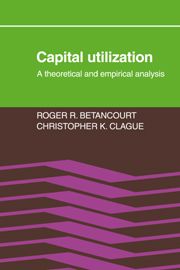Book contents
- Frontmatter
- Contents
- List of tables and figures
- List of propositions
- Preface
- Glossary of symbols
- Introduction
- 0 A preliminary view of capital utilization
- Part I Shift-work and the theory of the firm
- Part II Estimation
- 4 The estimation framework
- 5 Econometric literature on capital utilization: an interpretation
- 6 Empirical implementation
- Part III Results
- Part IV Implications
- References
- Index
5 - Econometric literature on capital utilization: an interpretation
Published online by Cambridge University Press: 05 March 2012
- Frontmatter
- Contents
- List of tables and figures
- List of propositions
- Preface
- Glossary of symbols
- Introduction
- 0 A preliminary view of capital utilization
- Part I Shift-work and the theory of the firm
- Part II Estimation
- 4 The estimation framework
- 5 Econometric literature on capital utilization: an interpretation
- 6 Empirical implementation
- Part III Results
- Part IV Implications
- References
- Index
Summary
At this point it is useful to review the current state of empirical knowledge about the long-run determinants of capital utilization in light of both the theory developed in Part I and the analysis in the preceding chapter. Given the long-run emphasis of our analysis, cross-sectional studies rather than time-series studies constitute the appropriate focus of our review. Because a major aim of this survey is to provide a perspective from which to view the empirical measurements and the results presented in the next two chapters, we shall discuss these cross-sectional studies from the point of view of testing propositions about the long-run determinants of capital utilization. Therefore, comments on descriptive material in these studies and comments on solely descriptive studies will be postponed until Chapter 8.
All but two of the studies under consideration are based on data for individual plants. The two exceptions are the early empirical studies on the subject (Marris 1964, Chapter 7; Winston 1971). Because these two studies illustrate the general nature of the problems faced by subsequent investigators, they will be discussed first. The remaining studies can be placed into the following two categories: those based on the use of continuous measures of utilization and those based on discrete measures of utilization. Because the choice of different utilization measures leads to some important differences between the two sets of studies, the two categories will be considered separately.
- Type
- Chapter
- Information
- Capital UtilizationA Theoretical and Empirical Analysis, pp. 90 - 103Publisher: Cambridge University PressPrint publication year: 1981



